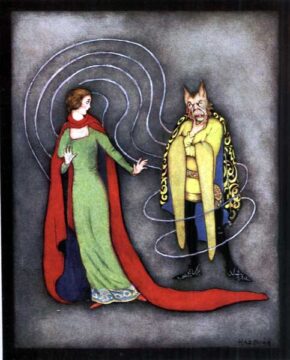by Jerry Cayford

It is almost Groundhog Day again. Time for the ritual rewatching of Groundhog Day, the comically ingenious and wildly successful retelling of “Beauty and the Beast.” More than just a delightful comedy, Groundhog Day does justice to the deep psychological roots of an ancient fairy tale (“Beauty and the Beast” is, along with “Rumpelstiltskin”—about which I wrote previously—in a small group of the oldest stories in Western literature), while reinventing it for our time.
Versions of “Beauty and the Beast” differ so greatly that it is hard to find a core set of elements, or confidently identify what is or isn’t a “version” of the story. (Wikipedia has a long list.) The larger category (ATU 425: The Search for the Lost Husband, or The Animal Bridegroom) includes “Cupid and Psyche,” from ancient Greece and Rome, where the husband is a god, not an animal, and it is Beauty who is tested and must change. Some stories start with marriage instead of ending there. In “East of the Sun and West of the Moon” (Norway), Beauty marries the white bear and only sees her husband as a beast by day. In the dark, though, he comes to her bed as a man, so long as she does not attempt to see his true form.
These tales are tales of alienation between a couple who do not know each other’s secrets, and do not trust each other. They live in material splendor in enchanted castles, and are lonely. The theme is how two become one.
Groundhog Day recreates “Beauty and the Beast” with clever narrative innovations. Usually, Beauty, a paragon of virtue, is the protagonist; but an unchanging protagonist makes for a static story: all the drama, all the change is happening in the secondary character, Beast. By making Beast the protagonist, Groundhog Day brings us close to the thematic action. Another narrative difficulty it solves is how a Beast isolated in a castle has time and reason for profound psychological change. (Fans of Disney’s versions create convoluted analyses about how long the story takes and how time must move differently in the castle and the town.) By giving Beast infinite time, Groundhog Day can thoroughly detail the stages of his transformation from self-centered jerk to caring community member, plausibly earning his release from the spell. Read more »
